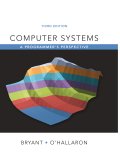
EBK COMPUTER SYSTEMS
3rd Edition
ISBN: 8220101459107
Author: O'HALLARON
Publisher: YUZU
expand_more
expand_more
format_list_bulleted
Question
Chapter 4.1, Problem 4.1PP
Program Plan Intro
Data movement instructions:
- The different instructions are been grouped as “instruction classes”.
- The instructions in a class performs same operation but with different sizes of operand.
- The “Mov” class denotes data movement instructions that copy data from a source location to a destination.
- The class has 4 instructions that includes:
- movb:
- It copies data from a source location to a destination.
- It denotes an instruction that operates on 1 byte data size.
- movw:
- It copies data from a source location to a destination.
- It denotes an instruction that operates on 2 bytes data size.
- movl:
- It copies data from a source location to a destination.
- It denotes an instruction that operates on 4 bytes data size.
- movq:
- It copies data from a source location to a destination.
- It denotes an instruction that operates on 8 bytes data size.
- movb:
Unary and Binary Operations:
- The details of unary operations includes:
- The single operand functions as both source as well as destination.
- It can either be a memory location or a register.
- The instruction “incq” causes 8 byte element on stack top to be incremented.
- The instruction “decq” causes 8 byte element on stack top to be decremented.
- The details of binary operations includes:
- The first operand denotes the source.
- The second operand works as both source as well as destination.
- The first operand can either be an immediate value, memory location or register.
- The second operand can either be a register or a memory location.
Jump Instruction:
- The “jump” instruction causes execution to switch to an entirely new position in program.
- The “label” indicates jump destinations in assembly code.
- The “je” instruction denotes “jump if equal” or “jump if zero”.
- The comparison operation is performed.
- If result of comparison is either equal or zero, then jump operation takes place.
- The “ja” instruction denotes “jump if above”.
- The comparison operation is performed.
- If result of comparison is greater, then jump operation takes place.
- The “pop” instruction resumes execution of jump instruction.
- The “jmpq” instruction jumps to given address. It denotes a direct jump.
Expert Solution & Answer
Want to see the full answer?
Check out a sample textbook solution
Chapter 4 Solutions
EBK COMPUTER SYSTEMS
Ch. 4.1 - Prob. 4.1PPCh. 4.1 - Prob. 4.2PPCh. 4.1 - Prob. 4.3PPCh. 4.1 - Prob. 4.4PPCh. 4.1 - Prob. 4.5PPCh. 4.1 - Prob. 4.6PPCh. 4.1 - Prob. 4.7PPCh. 4.1 - Prob. 4.8PPCh. 4.2 - Practice Problem 4.9 (solution page 484) Write an...Ch. 4.2 - Prob. 4.10PP
Ch. 4.2 - Prob. 4.11PPCh. 4.2 - Prob. 4.12PPCh. 4.3 - Prob. 4.13PPCh. 4.3 - Prob. 4.14PPCh. 4.3 - Prob. 4.15PPCh. 4.3 - Prob. 4.16PPCh. 4.3 - Prob. 4.17PPCh. 4.3 - Prob. 4.18PPCh. 4.3 - Prob. 4.19PPCh. 4.3 - Prob. 4.20PPCh. 4.3 - Prob. 4.21PPCh. 4.3 - Prob. 4.22PPCh. 4.3 - Prob. 4.23PPCh. 4.3 - Prob. 4.24PPCh. 4.3 - Prob. 4.25PPCh. 4.3 - Prob. 4.26PPCh. 4.3 - Prob. 4.27PPCh. 4.4 - Prob. 4.28PPCh. 4.4 - Prob. 4.29PPCh. 4.5 - Prob. 4.30PPCh. 4.5 - Prob. 4.31PPCh. 4.5 - Prob. 4.32PPCh. 4.5 - Prob. 4.33PPCh. 4.5 - Prob. 4.34PPCh. 4.5 - Prob. 4.35PPCh. 4.5 - Prob. 4.36PPCh. 4.5 - Prob. 4.37PPCh. 4.5 - Prob. 4.38PPCh. 4.5 - Prob. 4.39PPCh. 4.5 - Prob. 4.40PPCh. 4.5 - Prob. 4.41PPCh. 4.5 - Prob. 4.42PPCh. 4.5 - Prob. 4.43PPCh. 4.5 - Prob. 4.44PPCh. 4 - Prob. 4.45HWCh. 4 - Prob. 4.46HWCh. 4 - Prob. 4.47HWCh. 4 - Prob. 4.48HWCh. 4 - Modify the code you wrote for Problem 4.47 to...Ch. 4 - In Section 3.6.8, we saw that a common way to...Ch. 4 - Prob. 4.51HWCh. 4 - The file seq-full.hcl contains the HCL description...Ch. 4 - Prob. 4.53HWCh. 4 - The file pie=full. hcl contains a copy of the PIPE...Ch. 4 - Prob. 4.55HWCh. 4 - Prob. 4.56HWCh. 4 - Prob. 4.57HWCh. 4 - Our pipelined design is a bit unrealistic in that...Ch. 4 - Prob. 4.59HW
Knowledge Booster
Recommended textbooks for you
 Computer Networking: A Top-Down Approach (7th Edi...Computer EngineeringISBN:9780133594140Author:James Kurose, Keith RossPublisher:PEARSON
Computer Networking: A Top-Down Approach (7th Edi...Computer EngineeringISBN:9780133594140Author:James Kurose, Keith RossPublisher:PEARSON Computer Organization and Design MIPS Edition, Fi...Computer EngineeringISBN:9780124077263Author:David A. Patterson, John L. HennessyPublisher:Elsevier Science
Computer Organization and Design MIPS Edition, Fi...Computer EngineeringISBN:9780124077263Author:David A. Patterson, John L. HennessyPublisher:Elsevier Science Network+ Guide to Networks (MindTap Course List)Computer EngineeringISBN:9781337569330Author:Jill West, Tamara Dean, Jean AndrewsPublisher:Cengage Learning
Network+ Guide to Networks (MindTap Course List)Computer EngineeringISBN:9781337569330Author:Jill West, Tamara Dean, Jean AndrewsPublisher:Cengage Learning Concepts of Database ManagementComputer EngineeringISBN:9781337093422Author:Joy L. Starks, Philip J. Pratt, Mary Z. LastPublisher:Cengage Learning
Concepts of Database ManagementComputer EngineeringISBN:9781337093422Author:Joy L. Starks, Philip J. Pratt, Mary Z. LastPublisher:Cengage Learning Prelude to ProgrammingComputer EngineeringISBN:9780133750423Author:VENIT, StewartPublisher:Pearson Education
Prelude to ProgrammingComputer EngineeringISBN:9780133750423Author:VENIT, StewartPublisher:Pearson Education Sc Business Data Communications and Networking, T...Computer EngineeringISBN:9781119368830Author:FITZGERALDPublisher:WILEY
Sc Business Data Communications and Networking, T...Computer EngineeringISBN:9781119368830Author:FITZGERALDPublisher:WILEY

Computer Networking: A Top-Down Approach (7th Edi...
Computer Engineering
ISBN:9780133594140
Author:James Kurose, Keith Ross
Publisher:PEARSON

Computer Organization and Design MIPS Edition, Fi...
Computer Engineering
ISBN:9780124077263
Author:David A. Patterson, John L. Hennessy
Publisher:Elsevier Science

Network+ Guide to Networks (MindTap Course List)
Computer Engineering
ISBN:9781337569330
Author:Jill West, Tamara Dean, Jean Andrews
Publisher:Cengage Learning

Concepts of Database Management
Computer Engineering
ISBN:9781337093422
Author:Joy L. Starks, Philip J. Pratt, Mary Z. Last
Publisher:Cengage Learning

Prelude to Programming
Computer Engineering
ISBN:9780133750423
Author:VENIT, Stewart
Publisher:Pearson Education

Sc Business Data Communications and Networking, T...
Computer Engineering
ISBN:9781119368830
Author:FITZGERALD
Publisher:WILEY